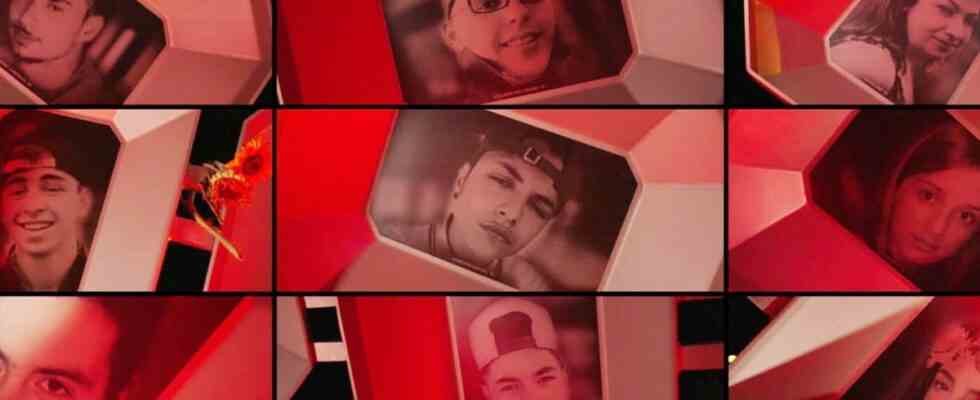For a moment you are very close to death in the television documentary “July 22nd – The Shots from Munich”. First, only a voice can be heard in a somewhat fuzzy, shaky mobile phone video: “Come on brother, look at me,” someone says, “Your name is Guiliano, isn’t it? What’s your name again?” Then two men come into the picture, lying on the floor, wearing blood-stained jeans, and you suspect that Guiliano won’t get up again.
Because Hüseyin Bayri, the other man on the floor, has already told how he threw himself down to the bleeding boy to help him, and he then goes on to tell how he tried to keep the boy alive, how he talked to him and slapped him so he wouldn’t close his eyes. In vain. Guiliano Kollmann is one of the nine victims of the right-wing extremist, racist assassin from the Olympia-Einkaufszentrum (OEZ), whose act marks the sixth anniversary of this Friday.
The scene lasts only seconds – long enough to convey the horror of that day; not enough for the suffering of those affected to be put on voyeuristic display. The face of the dying Guiliano cannot be seen; death is near, but you don’t look it straight in the eye.
The balancing act between sober but detailed presentation and sensationalism succeeds
Coverage of disasters walks a fine line where one must always be careful to stick to a sober yet descriptive narrative and not lapse into grandstanding. The director and author Johannes Preuss manages this balancing act in his four-part documentary, which will be available from this Thursday Sky Crime is broadcast. The series was produced by the TV company Constantin Documentation, in cooperation with the Süddeutsche Zeitung. The SZ police reporter Martin Bernstein is not only seen as an interview partner in front of the camera, he also advised the production team behind the scenes.
The result is a reconstruction and analysis of what happened on that July day in 2016 that is well worth seeing. Two of the four episodes, each almost 50 minutes long, deal with the course of events (episode 1, “A City in Panic” and episode 3, “The Act” ), the other two deal with the background (Episode 2, “The Perpetrator” and Episode 4, “The Terror Network”). The director Preuss looks at the attack from many perspectives, he interviewed relatives and eyewitnesses, politicians and police officers, lawyers, journalists and terror experts; even a friend and a girlfriend of the perpetrator have their say. Some of them are touching descriptions, in which one can see how the experience affects those affected years later. How they let their sentences reverberate before they continue to struggle for words.
How panic spread in Munich is a lesson in the influence of the new media
An emergency doctor tries to explain how first responders have to fight against their intuition in order to save as many people as possible: don’t treat the first injured person right away, but see if it isn’t more urgent for someone else. A forensics officer remembers the young victims’ mobile phones ringing at the crime scene – and how she imagined that mothers and fathers, siblings and friends were now hoping for a sign of life that would never come again.
The documentary provides viewers with exceptionally deep insights. In this way, one learns how panic that lasted for hours could spread in Munich on the evening of July 22, even though the crime had actually only lasted three minutes. The perpetrator David S. shot all of his nine victims between 5:51 p.m. and 5:54 p.m. and then hid for hours before killing himself. This aspect of the panic alone is a lesson in the influence of new mediaabout which false reports were spread and exaggerated at breakneck speed.
Otherwise, a customs investigator from Frankfurt reveals surprisingly openly how he tracked down the arms dealer who sold the assassin David S. a pistol and several hundred rounds of ammunition. And you also learn in which right-wing, racist and international network the perpetrator moved and obviously also radicalized. It is particularly interesting how the official assessment of the act changed over the years and in the course of new findings – from a simple killing spree to a right-wing extremist act of terrorism.
The documentary cannot answer some questions – but that says a lot
It wasn’t the case that the perpetrator wanted to take revenge for the bullying he suffered, as was initially said; for this he would have had to specifically visit his victims at his former school. But following the example of the Norwegian right-wing terrorist Anders Behring Breivik, he indiscriminately killed young people in their free time, all of whom had an obvious immigrant background in common. This racist motif is also conclusively worked out in the documentation.
As well as the documentation is made, it cannot answer all questions about the background. So it remains in the dark what is really going on with the acquaintance of David S., with whom he was together immediately before the crime, and whom the investigators do not classify as an accomplice. The assassin’s school would also have liked one or the other explanation of the allegations of bullying. However, the fact that the school does not want to contribute anything to public education also says a lot.
“July 22nd – The Shots of Munich”. All four episodes will be available on Sky and WOW from July 21st. Parts 1 and 2 air July 21 at 8:15 p.m. and 9 p.m., Parts 3 and 4 air July 28 at 8:15 p.m. and 9 p.m. on Sky Crime.

